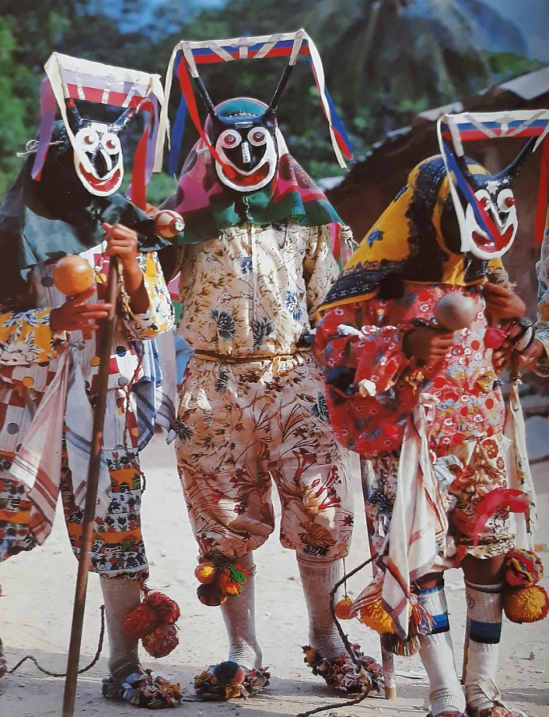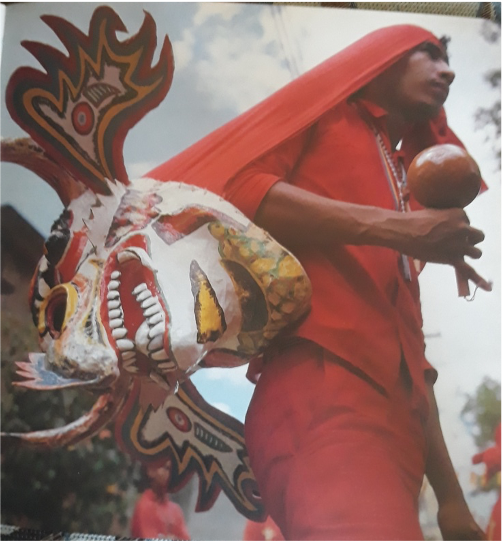Description
La celebración de Corpus Christi, tiene como manifestación a los Diablos Danzantes que representan la sumisión del demonio ante el poder del Santísimo Sacramento. Fiesta que tiene su origen en España y conserva un sentido mágico-religioso.
Los Diablos Danzantes son una manifestación popular tradicional correspondiente al calendario festivo de la Iglesia Católica. Día de Corpus Christi con fecha móvil, cae en junio, La fiesta tiene una duración de tres días.
Los Diablos Danzantes están organizados en once cofradías:
- Estado Aragua: En Cata, Chuao, Cuyagua, Ocumare de la Costa y Turiamo.
- Estado Carabobo: San Millán y Patanemo.
- Estado Cojedes: Tinaquillo.
- Estado Guárico: San Rafael de Orituco.
- Estado Miranda: San Francisco de Yare.
- La Guaira: Naiguatá
Los integrantes de las cofradías son todos varones a excepción de Naiguatá y Tinaquillo que admiten damas. Todos pagan contribuciones, asisten a la misa y a la procesión. Pero les está prohibido entrar a la Iglesia.
Los diablos se cubren con máscaras rituales coloridas y vistosas con gran variedad de formas y tamaños. Son diseños zoomorfos. Se elabora en papel maché, taparas o totumas (Se conoce en México como jícaras y guajes) y sobresalen los rasgos africanos.
En las máscaras de Naiguatá predominan los motivos de animales marinos, llevan en la parte superior un aro metálico con forma de cuernos, de los que cuelgan cintas de colores.
En San Francisco de Yare, predomina la cabeza de ganado vacuno. Las pintan al óleo. Según la jerarquía de los danzantes son la cantidad de cuernos. El primer capataz posee cuatro cuernos, el segundo tres y los demás llevan dos solamente.
En diciembre del 2012, los Diablos Danzantes de Corpus Christi fueron declarados por la UNESCO Patrimonio Cultural Inmaterial de la Humanidad.
English
Dancing devils for the Corpus Christi Festival
The celebration of Corpus Christi has as its manifestation the Dancing Devils which represent the submission of the devil before the power of the Blessed Sacrament. This festival has its origins in Spain and retains a magical-religious sense. The Dancing Devils are a traditional popular manifestation corresponding to the festive calendar of the Catholic Church. Corpus Christi Day, which falls in June, lasts for three days.
The Diablos Danzantes are organised in eleven confraternities:
Aragua State: In Cata, Chuao, Cuyagua, Ocumare de la Costa and Turiamo.
Carabobo State: San Millán and Patanemo.
Cojedes State: Tinaquillo.
Guárico State: San Rafael de Orituco.
Miranda State: San Francisco de Yare.
La Guaira: Naiguatá.
The members of the brotherhoods are all men except for Naiguatá and Tinaquillo, which admit women. They all pay contributions and attend mass and the procession. But they are forbidden to enter the church. The devils wear colourful and eye-catching ritual masks in a variety of shapes and sizes. They are zoomorphic designs. They are made of papier-mâché, “taparas” or “totumas”, in Mexico they are known as “jícaras y guajes” and the African features stand out.
In the masks of Naiguatá, the motifs of marine animals predominate, and they have a metallic ring in the shape of horns at the top, from which colourful ribbons hang. In San Francisco de Yare, cattle heads predominate. They are painted in oil. The number of horns depends on the hierarchy of the dancers. The first foreman has four horns, the second has three and the others have only two. In December 2012, the Diablos Danzantes de Corpus Christi were declared Intangible Cultural Heritage of Humanity by UNESCO.




Reviews
There are no reviews yet.